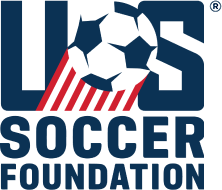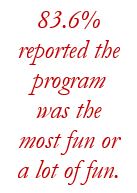

A popular youth development program for youth living in underserved communities is the U.S. Soccer Foundation’s free, after-school program, Soccer for Success, which is designed to engage students in soccer while teaching healthy lifestyle habits and critical life skills. The program also provides participants with trained coach-mentors and community engagement activities. In the 2017-2018 program year, co-ed Soccer for Success ran in more than 400 communities nationwide.
 For both girls and boys, it’s no secret that fun is the number one reason why they play sports1 and is also what keeps them playing, year after year.2,3,4 Girls, however, are less likely to participate in sports than boys.5 Consequently, girls achieve lower levels of physical activity,6 which has implications for their growth, development, and overall health.7 To encourage more female youth participation, the Foundation launched its first girls-only Soccer for Success sites in East Los Angeles earlier this year. In order to learn more about how to keep girls in the game, they reached out to me because of my team’s work engaging recreational and travel soccer players in mapping fun – aka, the FUN MAPS. Collectively, the maps illustrate 81 specific determinants of fun identified by the players – within 11 fun-factors – that represent the internal, external, social, and contextual aspects of youth sport participation.
For both girls and boys, it’s no secret that fun is the number one reason why they play sports1 and is also what keeps them playing, year after year.2,3,4 Girls, however, are less likely to participate in sports than boys.5 Consequently, girls achieve lower levels of physical activity,6 which has implications for their growth, development, and overall health.7 To encourage more female youth participation, the Foundation launched its first girls-only Soccer for Success sites in East Los Angeles earlier this year. In order to learn more about how to keep girls in the game, they reached out to me because of my team’s work engaging recreational and travel soccer players in mapping fun – aka, the FUN MAPS. Collectively, the maps illustrate 81 specific determinants of fun identified by the players – within 11 fun-factors – that represent the internal, external, social, and contextual aspects of youth sport participation. 
During the spring 2018 soccer season, we conducted a program evaluation of the 13 girls-only sites. The majority of the participants in the program reported Soccer for Success was maximally ‘the most fun’ (60.9%) or ‘a lot of fun’ (22.7%). Positive coaching from program staff, player effort (intrinsic motivation), and positive dynamics among teammates were reported as frequently occurring elements throughout the girls’ Soccer for Success experiences. Indeed, these evaluation results are consistent with our previous research, which found these determinants to be among the most important for soccer players. In addition, the girls reported their practices were consistent, structured, and well-organized. Practices also included lots of different partner-drills and small-group activities, and, yes, even water breaks. Though it might be surprising to some, these are all determinants that contribute to making sports fun for young athletes as reflected in the FUN MAPS.
 Notably, girls in the program also indicated an astute awareness of the value of being active, exercising, and hydration, which is likely reflective of the nutrition education component of the Soccer for Success program. They also reported a desire to continue learning and improving upon their soccer skills and many said they would be returning to play again next season.
Notably, girls in the program also indicated an astute awareness of the value of being active, exercising, and hydration, which is likely reflective of the nutrition education component of the Soccer for Success program. They also reported a desire to continue learning and improving upon their soccer skills and many said they would be returning to play again next season.
Why are these program evaluation findings important? Because sports like soccer may contribute to up to 60% of moderate-to-vigorous daily physical activity among youth9 and are an effective approach to obesity prevention.10 Furthermore, participating in sports, as opposed to exercise, offers unique cognitive, psychosocial, and social health benefits to children.11 That said, for kids to reap these benefits, they have to want to continue playing,12 and for that to happen, it has to be fun.8

This post was authored by Amanda J. Visek, PhD, Nicole Alfonsin, MPH, Kirsten Nottingham, Melissa Otterbein, & Avinash Chandran, PhD at The George Washington University, Milken Institute School of Public Health, Department of Exercise & Nutrition Sciences.
References